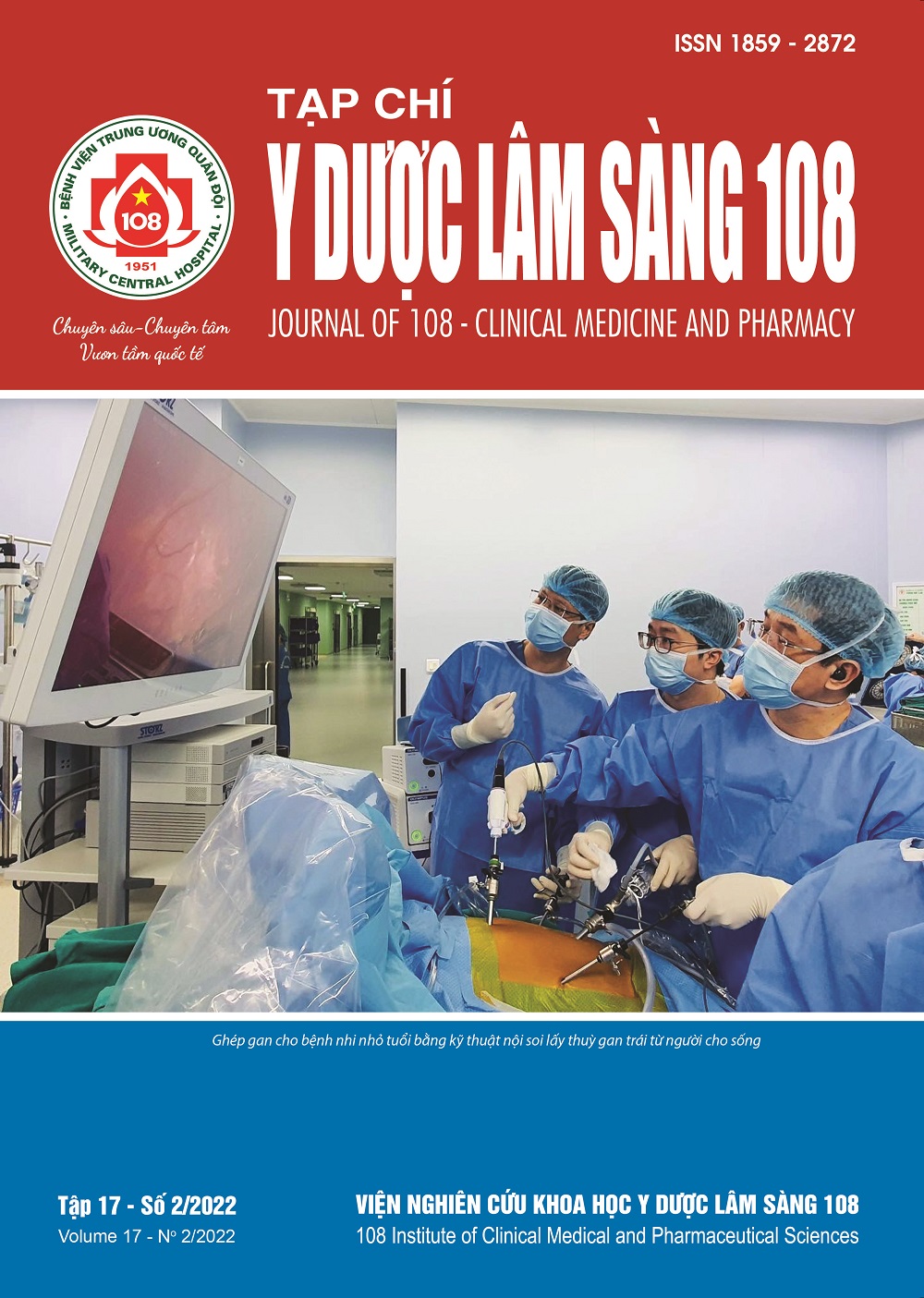Clinical, paraclinical and computed tomography characteristics of the chest in 44 cases of Staphylococcus aureus pneumonia treated at the Central Lung Hospital
Main Article Content
Keywords
Abstract
Objective: To describe the clinical, paraclinical characteristics and chest computed tomography (CT) images of the pneumonia cases caused by Staphylococcus aureus with clinical signs, and confirmed by diagnostic subclinical techniques. Subject and method: 44 patients with confirmed diagnosis of pneumonia caused by Staphylococcus aureus by culture method to isolate identification: Blood, sputum, bronchoalveolar lavage, pleural fluid with S. aureus (+) results. Method: Retrospective, descriptive, cross-sectional study. Result: Average age was 56.27 ± 19.5 years, male/female = 2.4/1; dry cough 9.1%, cough sputum 77.3%; hemoptysis 22.7%, shortness of breath 72.7%, fever (> 39ºC) 68.2%, chest pain 36.4%, average: White blood cells 15.31 ± 8.29G/L, red blood cells 3.97 ± 0.79T/L; Platelet cells 277.96 ± 8.29G/L, CRP 125.39 ± 86.19mg/l; PCT 47.58 ± 119.46ng/l. Sputum culture (+) with S. aureus: The first time 61.4%; the second 29.5%; third time 47.7%. Blood culture 1 sample (+) 40.9%; Blood culture 2 samples (+) 13.6%. Culture of bronchoalveolar lavage (+) with S. aureus 31.8% and pleural fluid 25.0%. CT scan results: Consolidation 72.7%, large nodules ≥ 3mm 45.5%; small nodules < 3mm 20.5%; cave/many caves 18.2%; lung cyst 9.1%, pneural effusion 22.7%; pneumothorax 2.3%; thickness pneural 22.7%; bronchiectasis 47.7%, pulmonary artery thromboembolism 4.5%; alveolar dilation 11.4%; large mediastinal lymph nodes 4.5%, and damage to both lungs 63.6%. Conclusion: Pneumonia caused by Staphylococcus aureus presents a variety of clinical, paraclinical and CT imaging features; features with a high frequency of occurrence play an important role in orienting and supporting the diagnosis of pneumonia caused by S. aureus.
Article Details
References
2. Webb RW and Charles BH (2017) Thoracic Imaging: Pulmonary and cardiovascular radilogy. Wolters Kluwer 3: 417-425.
3. Bộ Y tế (2020) Hướng dẫn chẩn đoán và điều trị viêm phổi mắc phải cộng đồng ở người lớn. Thông tư Bộ Y tế.
4. Bộ Y tế (2018) Niên giám Thống kê Y tế năm 2018. Nhà xuất bản Y học.
5. Lê Bật Tân (2018) Nghiên cứu đặc điểm lâm sàng, Xquang phổi và vi khuẩn gây bệnh của viêm phổi bệnh viện ở người lớn điều trị tại Bệnh viện Phổi Trung ương. Luận án Tiến sĩ Y học, Trường Đại học Y Hà Nội.
6. Lê Thị Kim Chung (2017) Nghiên cứu viêm phổi mắc phải trong bệnh viện ở người lớn tuổi. Luận văn Tiến sĩ Y học, Đại học Y Dược thành phố Hồ Chí Minh.
7. Self WH, Wunderink RG, Williams DJ, Zhu Y, Anderson EJ, Balk RA, Fakhran SS, Chappell JD, Casimir G, Courtney DM, Trabue C, Waterer GW, Bramley A, Magill S, Jain S, Edwards KM, Grijalva CG (2016) Staphylococcus aureus community acquired pneumonia: Prevalence, clinical characteristics and outcomes. Clin Infect Dis 63(3): 300-309. doi: 10.1093/cid/ciw300. PMID: 27161775.
8. Santos JW, Nascimento DZ, Guerra VA, Rigo Vda S, Michel GT, Dalcin TC (2018) Community-acquired staphylococcal pneumonia. J Bras Pneumol 34(9): 683-689. PMID: 18982205.
9. Sopena N, Heras E, Casas I, Bechini J, Guasch I, Pedro-Botet ML, Roure S, Sabrià M (2014) Risk factors for hospitalacquired pneumonia outs de the intensive care unit: A case-control study. Am J Infect Control 42(1): 38-42. Doi 10.1016/j.ajic.2013. 06.021. PMID: 24199911.
10. Nguyen ET, Kanne JP, Hoang LM, Reynolds S, Dhingra V, Bryce E, Müller NL (2008) Community-acquired methicillin-resistant Staphylococcus aureus pneumonia: Radiographic and computed tomography findings. J Thorac Imaging 23(1): 13-19. doi: 10.1097/RTI.0b013e318149e698. PMID: 18347514.
11. Tomita Y, Kawano O, Ichiyasu H, Fukushima T, Fukuda K, Sugimoto M, Kohrogi H (2008) Two cases of severe necrotizing pneumonia caused by community-acquired methicillin-resistant Staphylococcus aureus. Nihon Kokyuki Gakkai Zasshi 46(5): 395-403. PMID: 18517017.
12. Erdem G, Bergert L, Len K, Melish M, Kon K, DiMauro R (2010) Radiological findings of community-acquired methicillin-resistant and methicillin-susceptible Staphylococcus aureus pediatric pneumonia in Hawaii. Pediatr Radiol 40(11): 1768-1773. doi: 10.1007/s00247-010-1680-0. 14.PMID: 20467734
13. Michalopoulos A, Falagas ME (2006) Multi-systemic methicillin resistant Staphylococcus aureus (MRSA) community-acquired infection. Med Sci Monit. 12(5): 39-43. PMID: 16641881.
14. Miyazaki T, Yanagihara K, Kakeya H, Izumikawa K, Mukae H, Shindo Y, Yamamoto Y, Tateda K, Tomono K, Ishida T, Hasegawa Y, Niki Y, Watanabe A, Soma K, Kohno S (2020) Daily practice and prognostic factors for pneumonia caused by methicillin-resistant Staphylococcus aureus in Japan: A multicenter prospective observational cohort study. J Infect Chemother 26(2): 242-251. doi: 10.1016/j.jiac.2019.08.018. Epub 2019 Sep 28. PMID: 31575499
15. Wunderink RG, Niederman MS, Kollef MH, et al (2012) Linezolid in methicillin-resistant Staphylococcus aureus nosocomial pneumonia: A
randomized, controlled study. Clin Infect Dis 54(5): 621-629. doi:10.1093/cid/cir895. PMID: 22247123.
 ISSN: 1859 - 2872
ISSN: 1859 - 2872
